Blog & Latest Updates
Fly Fishing Articles
Insects by Common Name


Insect Order Diptera (True Flies)
Taxonomic Navigation -?-
Kingdom
Animalia (Animals)
» Phylum
Arthropoda (Arthropods)
» Class
Insecta (Insects)
» Order Diptera (True Flies)
21 families aren't included.
Common Name
| Match | Common Name |
| True Flies |
The most important family is Chironomidae, the midges. The craneflies of Tipulidae and the related families may also be important, as may be several of the others in the right place and time.
Pictures of 56 True Fly Specimens:
Male Stictochironomus Midge Adult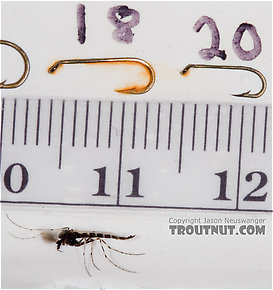 View 11 PicturesThis midge and several like it, including a female I also photographed, hatched from larvae which were living in some fine mud I'm using as substrate in my bug-rearing aquarium.
View 11 PicturesThis midge and several like it, including a female I also photographed, hatched from larvae which were living in some fine mud I'm using as substrate in my bug-rearing aquarium.
 View 11 PicturesThis midge and several like it, including a female I also photographed, hatched from larvae which were living in some fine mud I'm using as substrate in my bug-rearing aquarium.
View 11 PicturesThis midge and several like it, including a female I also photographed, hatched from larvae which were living in some fine mud I'm using as substrate in my bug-rearing aquarium.Collected April 10, 2007 from Mystery Creek #62 in New York
Added to Troutnut.com by Troutnut on April 10, 2007
Added to Troutnut.com by Troutnut on April 10, 2007
Tipulidae (Crane Flies) Crane Fly Adult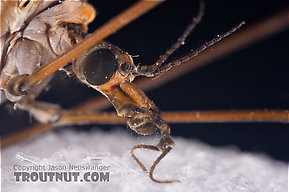 View 15 Pictures
View 15 Pictures
 View 15 Pictures
View 15 PicturesCollected May 29, 2007 from Brodhead Creek in Pennsylvania
Added to Troutnut.com by Troutnut on June 4, 2007
Added to Troutnut.com by Troutnut on June 4, 2007
Pedicia albivitta (Giant Eastern Crane Fly) True Fly Larva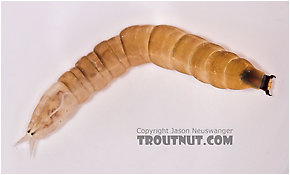 View 9 Pictures
View 9 Pictures
 View 9 Pictures
View 9 PicturesCollected March 29, 2005 from Fall Creek in New York
Added to Troutnut.com by Troutnut on April 6, 2006
Added to Troutnut.com by Troutnut on April 6, 2006
9 Underwater Pictures of True Flies:
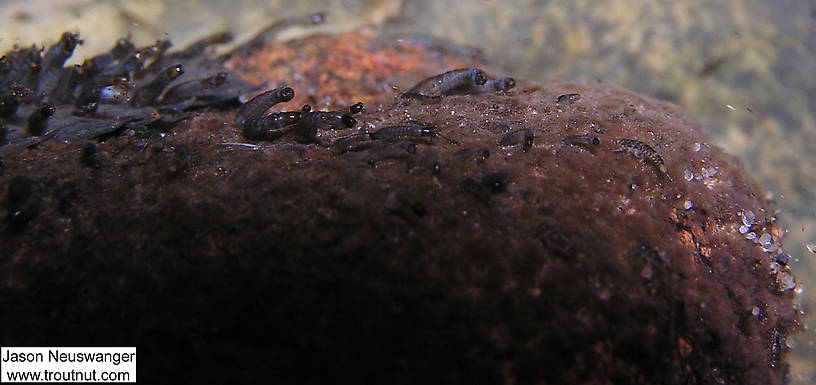
This is my favorite underwater picture so far. It shows a bunch of Simuliidae (black fly) larvae clinging to a rock and swinging in the fast current. There are also at least four visible mayfly nymphs, probably in the family Baetidae.
In this picture: True Fly Family Simuliidae (Black Flies) and Mayfly Family Baetidae (Blue-Winged Olives).
In this picture: True Fly Family Simuliidae (Black Flies) and Mayfly Family Baetidae (Blue-Winged Olives).
StateWisconsin
LocationEighteenmile Creek
Date TakenMar 19, 2004
Date AddedJan 25, 2006
AuthorTroutnut
CameraOlympus C740UZ
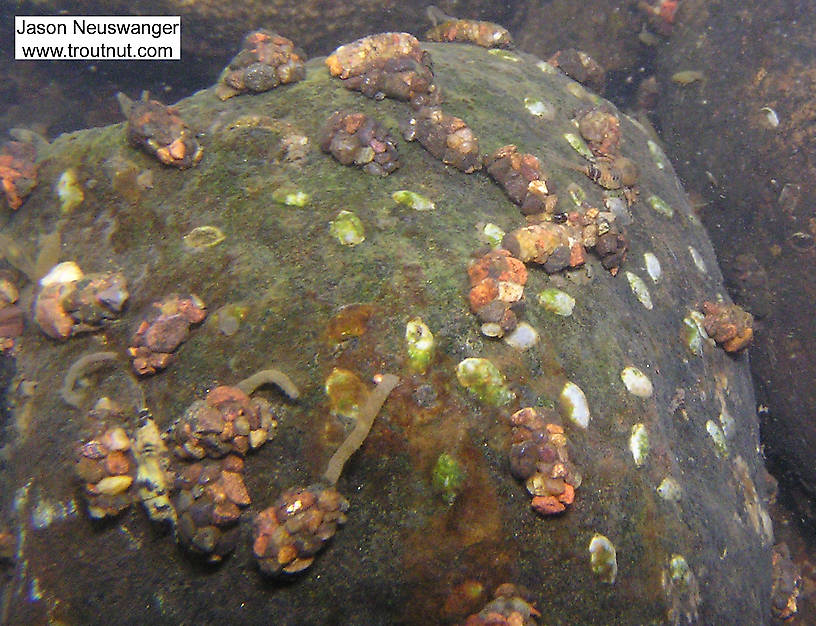
The white blotches on this rock are Leucotrichia caddisfly cases, and the wispy tubes are cases made by a type of midge.
In this picture: Mayfly Species Ephemerella invaria (Sulphur Dun), Caddisfly Species Leucotrichia pictipes (Ring Horn Microcaddis), and True Fly Family Chironomidae (Midges).
In this picture: Mayfly Species Ephemerella invaria (Sulphur Dun), Caddisfly Species Leucotrichia pictipes (Ring Horn Microcaddis), and True Fly Family Chironomidae (Midges).
StateWisconsin
LocationNamekagon River
Date TakenMar 24, 2004
Date AddedJan 25, 2006
AuthorTroutnut
CameraOlympus C740UZ
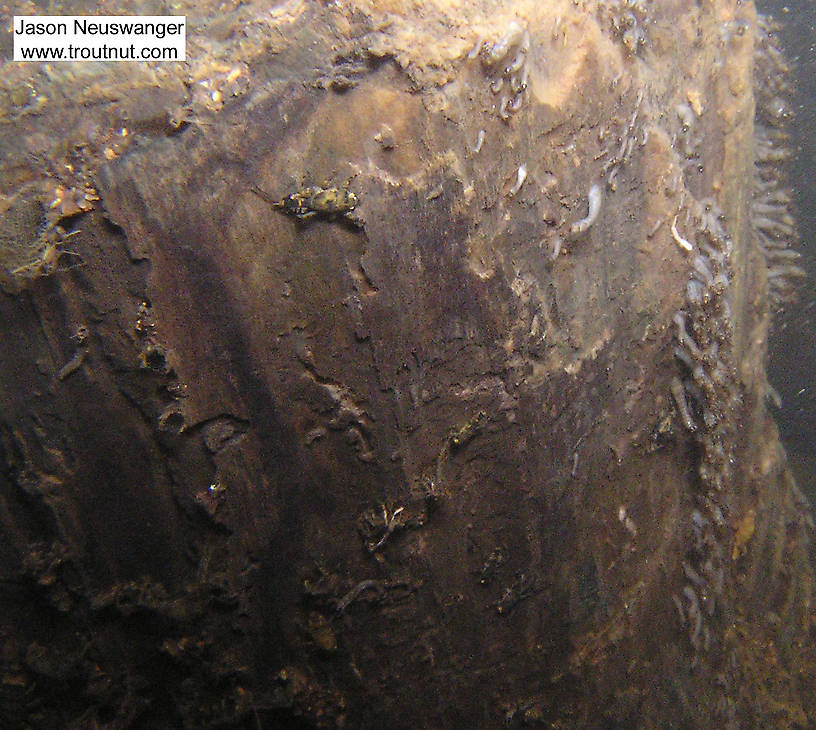
Some large Ephemerella mayfly nymphs cling to a log. In the background, hundreds of Simuliidae black fly larvae swing in large clusters in the current.
In this picture: Mayfly Species Ephemerella subvaria (Hendrickson), True Fly Family Simuliidae (Black Flies), and Mayfly Species Ephemerella invaria (Sulphur Dun).
In this picture: Mayfly Species Ephemerella subvaria (Hendrickson), True Fly Family Simuliidae (Black Flies), and Mayfly Species Ephemerella invaria (Sulphur Dun).
StateWisconsin
LocationNamekagon River
Date TakenMar 20, 2004
Date AddedJan 25, 2006
AuthorTroutnut
CameraOlympus C740UZ
Recent Discussions of Diptera
getting midges down 9 Replies »
Posted by CaseyP on Dec 8, 2007 in the family Chironomidae
Last reply on Jan 17, 2018 by Ummm
says here midge pupae rise in the water and struggle in the film to become adults. my imitations are so small that they don't seem to go down very far in order to rise--ike a wet fly might at the end of the swing. any ideas? or am i fishing them wrong?
ReplyClusters of midges and the Griffith's Gnat 35 Replies »Posted by Troutnut on Apr 10, 2007 in the family Chironomidae
Last reply on May 22, 2015 by Taxon
This is a spin-off from a tangent in another topic which seems worthy of its own thread.
I wrote about the midge I photographed:
Gonzo replied:
Those are the explanations I've heard, too, but I'm skeptical of both. I'm not doubting the effectiveness of the Griffith's Gnat; I just think people have traditionally stretched the bounds of credibility when trying to explain a fly's success in imitative terms, and this is one of the more prominent examples.
Has anybody here seen a cluster of midges on the water? I haven't. I have seen midges thickly grouped on rocks next to the water, and I don't doubt that they occasionally fall off of there, and probably sometimes two are three are clinging to each other. I've also seen early-season stoneflies balled up with each other in an opaque little (presumably mating-related) clump on a midstream boulder, and I wouldn't be surprised if some midge species do something like that too. But trout don't see balls of midges floating around very often on any stream I've ever observed. Has anyone experienced that?
In either case, I can't see something so opaque as a Griffith's Gnat effectively imitating what would surely be a loose ball of gangly entangled midges. You would have to roll them around in your fingers for a while to goo them together so solidly.
I just can't see the herl and hackle imitating, or even suggesting, a loosening pupal shuck. Shucks don't get that loose. They trail behind length-wise; they don't balloon to the sides. And they aren't pointy. Of course I'm sure Schwiebert knows all that and was just trying to add an idea to the mix of explanations, but I do find that one as far-fetched as the others.
Here's another far-fetched guess: maybe the hackle and refractive trickery in the surface film reduce the perceived thickness of the fly and it passes for a single midge pretty well. This could be tested in an aquarium but it's late and I'm feeling lazy.
I think it's more likely that when trout take a Griffith's Gnat they're only looking for (at most) the right general size and color. It's not as fun, but sometimes things are really that simple.
ReplyMidges 10 Replies »I wrote about the midge I photographed:
I'm not sure how a griffith's gnat is supposed to imitate such a thing
Gonzo replied:
Schwiebert's theory was that when it was awash in the film, the herl and halo of hackle suggested the loosening pupal shuck around the dark body of the emerging midge. Others have speculated that it imitates a cluster of midges. Both theories are reasonable, I suppose, depending on the size of the Griffith's Gnat that is effective relative to the size of the actual midge. Like many anglers, I just know that it does work. :)
Those are the explanations I've heard, too, but I'm skeptical of both. I'm not doubting the effectiveness of the Griffith's Gnat; I just think people have traditionally stretched the bounds of credibility when trying to explain a fly's success in imitative terms, and this is one of the more prominent examples.
Has anybody here seen a cluster of midges on the water? I haven't. I have seen midges thickly grouped on rocks next to the water, and I don't doubt that they occasionally fall off of there, and probably sometimes two are three are clinging to each other. I've also seen early-season stoneflies balled up with each other in an opaque little (presumably mating-related) clump on a midstream boulder, and I wouldn't be surprised if some midge species do something like that too. But trout don't see balls of midges floating around very often on any stream I've ever observed. Has anyone experienced that?
In either case, I can't see something so opaque as a Griffith's Gnat effectively imitating what would surely be a loose ball of gangly entangled midges. You would have to roll them around in your fingers for a while to goo them together so solidly.
I just can't see the herl and hackle imitating, or even suggesting, a loosening pupal shuck. Shucks don't get that loose. They trail behind length-wise; they don't balloon to the sides. And they aren't pointy. Of course I'm sure Schwiebert knows all that and was just trying to add an idea to the mix of explanations, but I do find that one as far-fetched as the others.
Here's another far-fetched guess: maybe the hackle and refractive trickery in the surface film reduce the perceived thickness of the fly and it passes for a single midge pretty well. This could be tested in an aquarium but it's late and I'm feeling lazy.
I think it's more likely that when trout take a Griffith's Gnat they're only looking for (at most) the right general size and color. It's not as fun, but sometimes things are really that simple.
Posted by Goose on Oct 24, 2006 in the family Chironomidae
Last reply on Jan 14, 2015 by Martinlf
Hi Jason & Gonzo! I did well over the weekend by fishing some midge pupa imitations as nymphs and in the film. Where does one find midge larva to inspect for pattern imitation? I fished the pupas and larvas on 5x tippet and it seemed to work well. Do midges live in the silt or on the bottom of rocks, etc.? I have the book by Ed Koch and ?, the other name escapes me for the moment, but it doesn't exactly say where they are found. Midges are about the game in in town during the winter months so I thought I'd learn a little about them. Thanks
ReplyThank you for the nice quality pictures. 1 Reply »Posted by Mushroom on Sep 22, 2014 in the family Simuliidae
Last reply on Sep 23, 2014 by Troutnut
Thank you for the nice quality pictures. I want to use your picture in my personal presentation in my science class. Would you mind this? I will wait your answer. thank you.
ReplyLife cycles and hatches 3 Replies »Posted by Leahdanger on Mar 7, 2014 in the family Chironomidae
Last reply on Mar 9, 2014 by Entoman
Hi,
I am trying to identify the life cycle of a few aquatic insects in eastern British Columbia. Specifically, I want to know if the species I collected in the fall (Aug-Oct) are a different hatch from the species I collected in the spring (April-May). Does anybody know when the following species lay eggs, die, and hatch: amphipods (Hyalella aztecha), chironomids, leeches, mayflies (Leptophlebiidae paraleptophlebia, Baetida sp.), and caddis flies (Oxyethira sp., Hydropsychidae arctopsyche)? For my purposes, knowing the general life cycle of amphipods and chironomids would be great.
Thanks much for your help!
Leah
ReplyI am trying to identify the life cycle of a few aquatic insects in eastern British Columbia. Specifically, I want to know if the species I collected in the fall (Aug-Oct) are a different hatch from the species I collected in the spring (April-May). Does anybody know when the following species lay eggs, die, and hatch: amphipods (Hyalella aztecha), chironomids, leeches, mayflies (Leptophlebiidae paraleptophlebia, Baetida sp.), and caddis flies (Oxyethira sp., Hydropsychidae arctopsyche)? For my purposes, knowing the general life cycle of amphipods and chironomids would be great.
Thanks much for your help!
Leah
There are 9 more topics.
Your Thoughts On Diptera:
Top 10 Fly Hatches
Top Gift Shop Designs
Eat mayflies.
Top Insect Specimens
Miscellaneous Sites
Troutnut.com is copyright © 2004-2024 Jason
Neuswanger (email Jason). See my FAQ for information about use of my images.
 privacy policy
privacy policy
